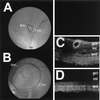Stable transgene expression in rod photoreceptors after recombinant adeno-associated virus-mediated gene transfer to monkey retina
- PMID: 10449795
- PMCID: PMC22311
- DOI: 10.1073/pnas.96.17.9920
Stable transgene expression in rod photoreceptors after recombinant adeno-associated virus-mediated gene transfer to monkey retina
Abstract
Recombinant adeno-associated virus (rAAV) is a promising vector for therapy of retinal degenerative diseases. We evaluated the efficiency, cellular specificity, and safety of retinal cell transduction in nonhuman primates after subretinal delivery of an rAAV carrying a cDNA encoding green fluorescent protein (EGFP), rAAV. CMV.EGFP. The treatment results in efficient and stable EGFP expression lasting >1 year. Transgene expression in the neural retina is limited exclusively to rod photoreceptors. There is neither electroretinographic nor histologic evidence of photoreceptor toxicity. Despite significant serum antibody responses to the vector, subretinal readministration results in additional transduction events. The findings further characterize the retinal cell tropism of rAAV. They also support the development of studies aimed ultimately at treating inherited retinal degeneration by using rAAV-mediated gene therapy.
Figures




References
-
- Bunker C H, Berson E L, Bromley W C, Hayes R P, Roderick T H. Am J Ophthalmol. 1984;97:357–365. - PubMed
-
- Kaplan J, Bonneau D, Frezal J, Munnich A, Dufier J L. Hum Genet. 1990;85:635–642. - PubMed
-
- National Advisory Eye Council. National Institutes of Health Publication 93-3186. Bethesda, MD: National Institutes of Health; 1993.
-
- Blacharski P A. In: Fundus flavimaculatus. Newsome D A, editor. NY: Raven; 1988. pp. 135–159.
Publication types
MeSH terms
Substances
Grants and funding
LinkOut - more resources
Full Text Sources
Other Literature Sources
Medical

